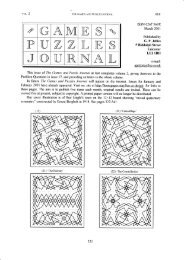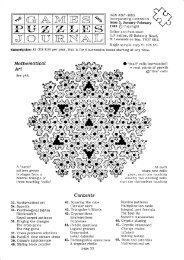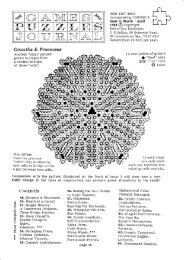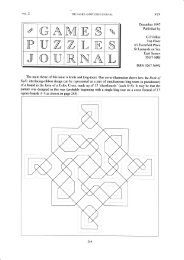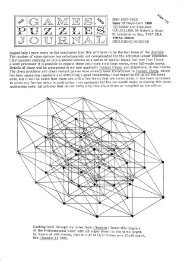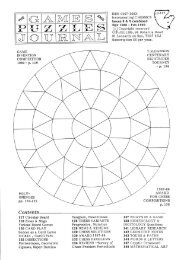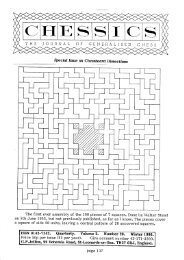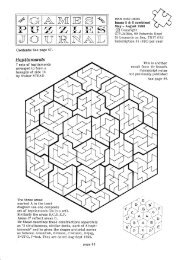The Games and Puzzles Journal, #7 - Mayhematics
The Games and Puzzles Journal, #7 - Mayhematics
The Games and Puzzles Journal, #7 - Mayhematics
Create successful ePaper yourself
Turn your PDF publications into a flip-book with our unique Google optimized e-Paper software.
THE GAMES AND PVZZLES JOURNAL^$-**'Crvrhsation.$95) A game that seeks to reconstruct the history of the world would seem to be theultimate ambition of the Simulationist branch of games philosophy - <strong>and</strong> this game seeksto do Just that - or at least, the history of the Eastern Mediterranean region rFrom theDawn of History to 250BCr, <strong>and</strong> succeeds quite well - though any such proJect is inevitablyopen to criticism for being neither didactically sound history nor tacticaliy pure game.<strong>The</strong> game was issued in September by H.P.Gibson & Sons Ltd, but appears to havebeen published previously in 1980 by a Northampton company. <strong>The</strong> designer, F.G.Tresham,is acknowledged, together with a test <strong>and</strong> developinent team. I note also that the gamewas tried oui for postal play in TROG (now ceased). It is currently on offer in Riqq4a<strong>Games</strong> Review.It would need care][flEbptation for this method of play.<strong>The</strong> boardr as produced by Gibsonrs, consists of four parts that fit together inthe fashion of a Jigsaw. <strong>The</strong>re are seven players (or fewer in special versions) <strong>and</strong> eachis provided with 50+ tokens, these are printed on thick card, ready to be pushed out.<strong>The</strong> rules of play, as might be expected, are extensive so only a sketch can begiven here. War-gaming is only a part of the strategy - 'the obJect of the game is togain a level of overall advancement involving cultural, economic <strong>and</strong> political factorsso that such conflicts as arise are due to rivalry <strong>and</strong> l<strong>and</strong> shortage'- the level of advancementis measured by accumulation of points. At the start each plaver has one tokenvalued at one point - representing a nomadic tribe. <strong>The</strong> tribes exp<strong>and</strong> into nations, formcities, accumulate trading commodities, <strong>and</strong> acquire arts, crafts, science <strong>and</strong> law.<strong>The</strong> materials traded in, the number of cards of each, <strong>and</strong> their individual valuesare as follows: Gold (3) 9, Gems (4) 8, Spice (5) ?, Bronze (6) 6, Cloth (7) 5, Grain (8) 4,Salt (9) 3, Iron (5) 2, Papyrus (5) 2, Hides (7) 1, Ochre (7) 1. In addition, among the tradecards, are 8 catastrophe cards: Piracy, Iconoclasm & Heresy, Civil Disorder, EpidemictCivil War, Famine, Flood, Volcanic Eruption or Earthquake. <strong>The</strong>re are 74 cards in all.Trade leads to civilisation, represented by exchange of trade cards for civilisationcards. <strong>The</strong>re are 72 of these in four tsuitst: Arts (blue), Sciences (green), Crafts (orange),Civics (pink); some cards belong to two suits. <strong>The</strong> distribution of these <strong>and</strong> their valuesare: Green: Medicine (4) 140, Coinage (4) 110, Astronomy (4) 80. Blue: Music (4) 60,Drama & Poetry (4) 60. Blue-green: Mysticism (3) 30. Blue-pink: Literacy (6) 110, Architecture(0) eo. Pink: Philosophy (5) 240, Democracy (5) 200, l,aw (7) 170. orange: Agriculture(4) 110, Metalworking (a) 80, Cloth-making (4) 45, Pottery (4) 45. Orange-green:Engineering (4) 140.<strong>The</strong> progress of each player towards civilisation is in five 'epochst, recorded ona progress chart in one corner of the board. To pass into the 2nd epoch one must havebuilt two cities, to pass into the third one must have civilisation cards from three suits.<strong>The</strong> 4th epoch requires 7 civilisation cards, <strong>and</strong> the 5th epoch civilisation cards totalling1000 points. After these hurdles it is then a race for the finish line.<strong>The</strong>re is no dice play. Each round'the population of each zone is increased by twounits (or by one in the case of a zone of one unit) <strong>and</strong> each unit may move across oneboundary. Population movement is forced because each zone has a specified maximumpopulation it can support. Population pressure can also be eased by bringing six unitstogether to form a city, on one of the city sites marked on the map. Conflict resultswhen two, or more, players try to occupy the same zone <strong>and</strong> exceed the limit it cansupport. <strong>The</strong> basic rule is that both combatants reduce their population in the area byequal amounts, but possession of metalworking craft will give extra advantage.<strong>The</strong>re is also provision for ship-building, to permit faster migration. A ship coststwo units, plus regular maintenance, <strong>and</strong> caruies up to 5 tokens a distance of 4 zonesalong the coast. Possession of cloth-making for sails speeds the vessels, <strong>and</strong> astronomyenables sea navigation. This is perhaps the most original aspect of the game.Possession of civilisation cards gives advantages against calamities, e.S. medicineagainst epidemic, engineering agai4st flood, agriculture against famine. law democracy<strong>and</strong> philosophy against civil war or disorder.An ambitious game, difficult to evaluate without extensive playing experience.If it is all too much to take in at one gulp, the simplified versions, Nomads <strong>and</strong> Seafarers,or Farmers <strong>and</strong> Citizens, can be played on the same board.page L02




